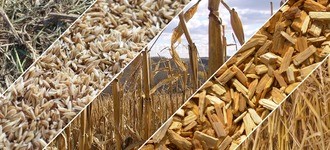Pellet production involves converting various raw materials into compacted, high-energy pellets suitable for use in industrial boilers, Combined Heat and Power (CHP) systems, and power plants. Key factors influencing the suitability of raw materials include their chemical composition (lignin, cellulose, hemicellulose content) and calorific value. Below is a detailed description of these properties for commonly used raw materials.
Soft Wood
Chemical Properties:
- Lignin: 25-30%
- Cellulose: 40-45%
- Hemicellulose: 25-30%
Physical Properties:
- Density: 350-450 kg/m³
- Moisture Content: Up to 40%
- Particle Size: Typically 1-5 mm after processing
Calorific Value: 4,500-4,800 kcal/kg
Hard Wood
Chemical Properties:
- Lignin: 20-25%
- Cellulose: 45-50%
- Hemicellulose: 20-25%
Physical Properties:
- Density: 500-700 kg/m³
- Moisture Content: Up to 40%
- Particle Size: Typically 1-5 mm after processing
Calorific Value: 4,800-5,200 kcal/kg
Wood Chips
Chemical Properties:
- Lignin: 20-30%
- Cellulose: 40-50%
- Hemicellulose: 20-30%
Physical Properties:
- Density: 300-600 kg/m³
- Moisture Content: Up to 35%
- Particle Size: Typically 5-35 mm
Calorific Value: 4,500-5,000 kcal/kg
Fire Wood (Saw Mill Waste)
Chemical Properties:
- Lignin: 20-25%
- Cellulose: 40-50%
- Hemicellulose: 20-30%
Physical Properties:
- Density: 350-550 kg/m³
- Moisture Content: Up to 20%
- Particle Size: Varies depending on waste type
Calorific Value: 4,500-5,000 kcal/kg
Rice Straw
Chemical Properties:
- Lignin: 10-15%
- Cellulose: 30-40%
- Hemicellulose: 25-35%
Physical Properties:
- Density: 100-200 kg/m³
- Moisture Content: Up to 20%
- Particle Size: Typically 1-5 mm after processing
Calorific Value: 3,200-3,800 kcal/kg
Corn (Maize) Cobs
Chemical Properties:
- Lignin: 15-20%
- Cellulose: 35-40%
- Hemicellulose: 30-35%
Physical Properties:
- Density: 250-350 kg/m³
- Moisture Content: Up to 35%
- Particle Size: Typically 5-15 mm
Calorific Value: 4,000-4,500 kcal/kg
Rice Husk
Chemical Properties:
- Lignin: 20-25%
- Cellulose: 30-35%
- Hemicellulose: 20-25%
Physical Properties:
- Density: 100-200 kg/m³
- Moisture Content: Up to 15%
- Particle Size: Typically <1 mm
Calorific Value: 3,000-3,500 kcal/kg
Sugarcane Bagasse
Chemical Properties:
- Lignin: 20-25%
- Cellulose: 40-45%
- Hemicellulose: 25-30%
Physical Properties:
- Density: 100-150 kg/m³
- Moisture Content: Up to 40%
- Particle Size: Typically 5-20 mm
Calorific Value: 2,700-3,200 kcal/kg
Saw Dust
Chemical Properties:
- Lignin: 20-30%
- Cellulose: 40-50%
- Hemicellulose: 20-30%
Physical Properties:
- Density: 200-400 kg/m³
- Moisture Content: Up to 35%
- Particle Size: Typically <1 mm
Calorific Value: 4,000-4,500 kcal/kg
Mustard Stalk
Chemical Properties:
- Lignin: 15-20%
- Cellulose: 35-40%
- Hemicellulose: 25-30%
Physical Properties:
- Density: 150-250 kg/m³
- Moisture Content: Up to 18%
- Particle Size: Typically 1-5 mm after processing
Calorific Value: 3,500-4,000 kcal/kg
Empty Fruit Bunch (EFB)
Chemical Properties:
- Lignin: 20-25%
- Cellulose: 35-40%
- Hemicellulose: 20-25%
Physical Properties:
- Density: 100-150 kg/m³
- Moisture Content: Up to 35%
- Particle Size: Typically 5-20 mm
Calorific Value: 3,500-4,000 kcal/kg
Napier Grass
Chemical Properties:
- Lignin: 10-15%
- Cellulose: 40-45%
- Hemicellulose: 30-35%
Physical Properties:
- Density: 150-250 kg/m³
- Moisture Content: Up to 55%
- Particle Size: Typically 1-5 mm after processing
Calorific Value: 3,500-4,000 kcal/kg
Lignin, Cellulose, and Hemicellulose
Lignin: A complex organic polymer found in the cell walls of plants, providing structural support, rigidity, and resistance to decay. It is crucial for the mechanical strength of biomass and contributes to the energy content of pellets due to its high carbon content.
Cellulose: A polysaccharide consisting of linear chains of glucose molecules. It forms the primary structural component of plant cell walls and is a major contributor to the fibrous nature of biomass. Cellulose content significantly impacts the durability and energy content of pellets.
Hemicellulose: A group of polysaccharides that, unlike cellulose, have a branched structure. Hemicellulose binds with cellulose fibers, adding flexibility and strength to plant cell walls. It influences the thermal and mechanical properties of pellets.
Summary Table
Raw Material | Lignin (%) | Cellulose (%) | Hemicellulose (%) | Density (kg/m³) | Moisture Content (%) | Particle Size (mm) | Calorific Value (kcal/kg) |
Soft Wood | 25-30 | 40-45 | 25-30 | 350-450 | Up to 40 | 1-5 | 4,500-4,800 |
Hard Wood | 20-25 | 45-50 | 20-25 | 500-700 | Up to 40 | 1-5 | 4,800-5,200 |
Wood Chips | 20-30 | 40-50 | 20-30 | 300-600 | Up to 35 | 5-35 | 4,500-5,000 |
Fire Wood (Saw Mill) | 20-25 | 40-50 | 20-30 | 350-550 | Up to 20 | Varies | 4,500-5,000 |
Rice Straw | 10-15 | 30-40 | 25-35 | 100-200 | Up to 20 | 1-5 | 3,200-3,800 |
Corn (Maize) Cobs | 15-20 | 35-40 | 30-35 | 250-350 | Up to 35 | 5-15 | 4,000-4,500 |
Rice Husk | 20-25 | 30-35 | 20-25 | 100-200 | Up to 15 | <1 | 3,000-3,500 |
Sugarcane Bagasse | 20-25 | 40-45 | 25-30 | 100-150 | Up to 40 | 5-20 | 2,700-3,200 |
Saw Dust | 20-30 | 40-50 | 20-30 | 200-400 | Up to 35 | <1 | 4,000-4,500 |
Mustard Stalk | 15-20 | 35-40 | 25-30 | 150-250 | Up to 18 | 1-5 | 3,500-4,000 |
Empty Fruit Bunch (EFB) | 20-25 | 35-40 | 20-25 | 100-150 | Up to 35 | 5-20 | 3,500-4,000 |
Napier Grass | 10-15 | 40-45 | 30-35 | 150-250 | Up to 55 | 1-5 | 3,500-4,000 |
Additional Considerations
- Moisture Content: Maintaining a moisture content of 15% or lower is essential for efficient pellet production and combustion.
- Density: Higher density materials typically produce pellets with greater energy content and durability.
- Particle Size: Uniform particle size is crucial for efficient processing and pellet quality.
Conclusion
Selecting the appropriate raw material with optimal chemical and physical properties is vital for high-quality pellet production. Understanding the lignin, cellulose, and hemicellulose content, along with the calorific value, can help in choosing the best material for your specific application in industrial boilers, CHP systems, and power plants.




